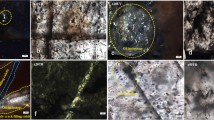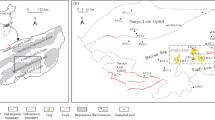Abstract
The Ordovician carbonate reservoirs in the Tahe Oilfield are highly heterogeneous, which have undergone multiple superimposed transformations by tectonic activities and karst processes, leading to an extremely complex fluid distribution. The geochemical characteristics of geofluids also display great disparities. Results show that the vertical distribution of oil and gas are continuous, however the oil-water interfaces in different blocks of the Tahe Ordovician Oilfield are numerous. Meteoric water infiltration is regarded as the main reason for the high oil-water interface and high water content to the north of Tahe Oilfield, especially in well blocks S78−S73. The isotopic values of deuterium-oxygen in the groundwater and carbon-oxygen from calcite veins confirm that formation water in Ordovician reservoirs of the Tahe Oilfield was a mix of meteoric water and connate water, and the proportion of meteoric water gradually increases from south to north, while connate water decreases. The Tahe Ordovician reservoirs are characterised by multiple hydrocarbon charges, and the general migrating direction is from southeast to northwest and from east to west. High production could be obtained in the northern area of the Tahe Oilfield since the oil layers are thick and oil is highly saturated. The residual water within the reservoirs is low, and heavy oil is dominant in this area. Only a small amount of pore water has been replaced by oil in the southern Tahe Oilfield, leading to low oil saturation and a high content of residual water. Crude oil is herein mainly of medium-light type. During the process of exploration in this region, acid fracturing reformation is usually required for wells to increase their output; however the yield is still low.
Similar content being viewed by others
References Cited
Bachu, S., Michael, K., 2003. Possible Controls of Hydrogeological and Stress Regimes on the Producibility of Coalbed Methane in Upper Cretaceous-Tertiary Strata of the Alberta Basin, Canada. AAPG Bulletin, 87(11): 1729–1754
Birkle, P., Rosillo Aragon, J. J., Portugal, E., et al., 2002. Evolution and Origin of Deep Reservoir Water at the Activo Luna Oil Field, Gulf of Mexico, Mexico. AAPG Bulletin, 86(3): 457–484
Cai, C. F., 2000. Evidence for Origin and Mixing of Oilfield Waters from Paleozoic Strata in Tazhong Area. Geochimica, 29(5): 504–510 (in Chinese with English Abstract)
Dickinson, W. W., 1987. An Oxygen Isotope Model for Interpreting Carbonate Diagenesis in Non-Marine Rocks (Green River Basin, Wyoming, USA). Chemical Geology, 65(2): 103–116
Gu, Y., Huang, J. W., Shao, Z. B., 2003. Petroleum Geochemistry and Hydrocarbon Migration in Tahe Oilfield of the Tarim Basin. Petroleum Geology & Experiment, 25(6): 746–750 (in Chinese with English Abstract)
Li, M., Lou, Z. H., Jin, A. M., et al., 2013. Origin, Flow of Formation Water and Hydrocarbon Accumulation in the Zhenwu Area of the North Jiangsu Basin, China. Acta Geologica Sinica, 87(3): 819–829
Lin, R. Z., Zhang, M., 1996. Reservoir-Geochemistry—The Latest Progress in Petro-Geochemistry. Journal of Xi’an Petroleum Institute, 11(1): 8–14 (in Chinese)
Lou, Z. H., Zhu, R., Yun, L., et al., 2008. Distribution of the Ordovician Fluid in the Tahe Oilfield and Dynamic Response of Cave System S48 to Exploitation. Acta Geologica Sinica (English Edition), 82(3): 487–498
Ma, Y. S., Lou, Z. H., Guo, T. L., et al., 2006. An Exploration on a Technological System of Petroleum Preservation Evaluation for Marine Strata in South China. Acta Geologica Sinica, 80(3): 406–417 (in Chinese with English Abstract)
Pan, H. P., Luo, M., Zhang, Z. Y., et al., 2010. Lateral Contrast and Prediction of Carboniferous Reservoirs Using Logging Data in Tahe Oilfield, Xinjiang, China. Journal of Earth Science, 21(4): 480–488
Pang, W., Jiang, T. W., Zheng, J. M., et al., 2007. Characteristics of the Ordovician Buried Hill Reservoirs in the Tahe-Lunnan Oil Area. Oil & Gas Geology, 28(6): 762–767 (in Chinese)
Pu, R. H., Zhang, Y. L., Luo, J. L., 2012. Seismic Reflection, Distribution, and Potential Trap of Permian Volcanic Rocks in the Tahe Field. Journal of Earth Science, 22(4): 421–430
Sorenson, R. P., 2005. A Dynamic Model for the Permian Panhandle and Hugoton Fields, Western Anadarko Basin. AAPG Bulletin, 89: 921–938
Stueber, A. M., Saller, A. H., Ishida, H., 1998. Origin, Migration, and Mixing of Brines in the Permian Basin: Geochemical Evidence from the Eastern Central Basin Platform, Texas. AAPG Bulletin, 82: 1652–1672
Sun, L. D., Li, R. J., Jiang, T. W., et al., 2007. The Central Tarim Lower Uplift: A Composite Hydrocarbon Accumulation Play in the Tarim Basin, NW China. Chinese Journal of Geology, 42(3): 602–620 (in Chinese with English Abstract)
Wang, Y. P., Lin, J. X., Wang, L., 1995. Division of Water-Bearing System and Hydrogeological Periods of Oil (Gas)-Bearing Basin: With Xihu Depression in East China Sea as an Example. Earth Science—Journal of China University of Geosciences, 20(4): 393–398 (in Chinese with English Abstract)
Wang, C. G., Wang, T. G., He, F. Q., et al., 2005. Stable Carbon Isotope and Its Significance in Hydrocarbon Accumulation in Tahe Oilfield, Tarim Basin. Xinjiang Petroleum Geology, 26(2): 155–157 (in Chinese with English Abstract)
Wang, J., Gu, Y., Rao, D., et al., 2007. Geochemistry, Genetic Type and Migration and Filling of Ordovician Natural Gas in Tahe Oilfield. Geochemica, 36(6): 549–558 (in Chinese with English Abstract)
Xiao, Y. R., He, F. Y., Sun, Y. M., 2003. Analysis on Carbonate Reservoir Characteristics of the Ancient Cave—Take Tahe Oilfield Ordovician Cave for Example. Oil & Gas Geology, 24(1): 75–80 (in Chinese)
Yang, F., Zou, C. N., Hou, L. H., et al., 2013. Hydrocarbon Distribution and Accumulation Model in the South of Lixian Slope, Raoyang Subbasin. Journal of Earth Science, 24(6): 1033–1043
Zhu, R., Lou, Z. H., Yun, L., et al., 2008a. Occurrence and Distribution of Formation Water in the Ordovician Reservoirs of the Tahe Oilfield. Chinese Journal of Geology, 43(2): 228–237 (in Chinese with English Abstract)
Zhu, R., Lou, Z. H., Yun, L., et al., 2008b. Development Performance of Ordovician Reservoir and Hydrochemical Response in the Tahe Oilfield. Acta Geologica Sinica, 82(3): 397–406 (in Chinese with English Abstract)
Author information
Authors and Affiliations
Corresponding author
Rights and permissions
About this article
Cite this article
Li, M., Lou, Z., Zhu, R. et al. Distribution and geochemical characteristics of fluids in Ordovician marine carbonate reservoirs of the Tahe Oilfield. J. Earth Sci. 25, 486–494 (2014). https://doi.org/10.1007/s12583-014-0453-3
Received:
Accepted:
Published:
Issue Date:
DOI: https://doi.org/10.1007/s12583-014-0453-3




